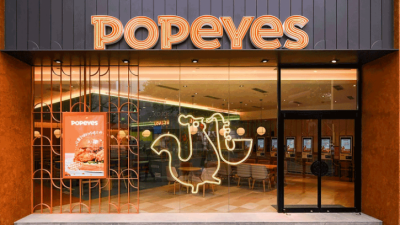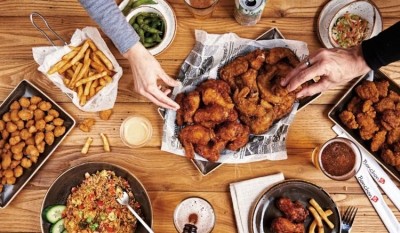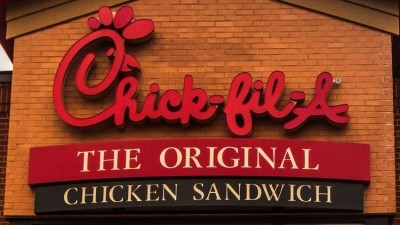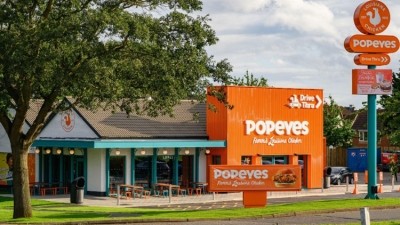Business Profile
Southern pride: the Louisiana fried chicken brand that’s coming in hot
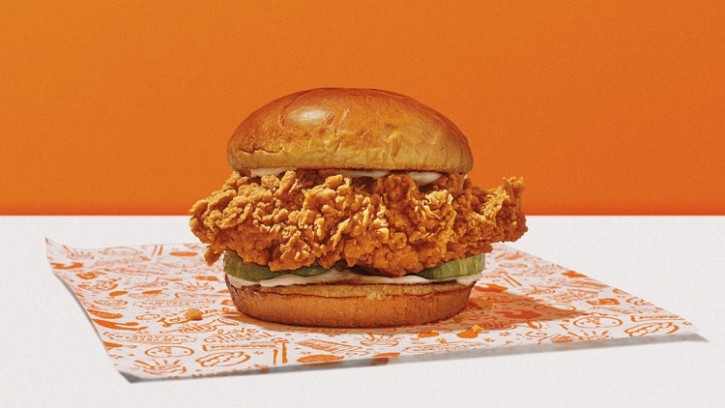
When Popeyes UK COO Neil Williamson first heard that the Louisiana-founded fried chicken chain was going to include biscuits and gravy on its launch menu, he wasn’t entirely convinced it would work. “We debated it at length before we opened,” he says. “We were going to be the first Popeyes in Europe to launch the biscuit. Obviously, they’re well known in US, but in the UK, people aren’t familiar with them.”
Williamson was right to be sceptical. Many brands have tried to bring the Southern staple of biscuits and gravy to the UK before and all failed. To a British diner, the biscuits themselves are closer in appearance and texture to a traditional scone; not exactly the sort the thing they might feel inclined to dunk in a pot of Cajun-spiced gravy. Convincing them to do so seemed to be a tough sell.
“We came to the conclusion it was a product to differentiate us from everyone else in the market,” Williamson continues. “For the price [a biscuit and gravy pot costs around £2], as a consumer it’s cheap enough to make you want to try it. We had an open-minded approach and if it didn’t work, we would have revised the menu.”
It was quickly apparent, though, that no revisions to the menu would be necessary. On the second day of trading at Popeyes’s inaugural UK site, located within Stratford’s Westfield Shopping Centre in London, one customer queued for hours to put in an order for 50 biscuits. “I was convinced it was a mistake on the till, but it wasn’t. And now we’re selling thousands of biscuits. Our guests have responded really well to them, and as a result other Popeyes restaurants in Europe are adding them to their menu too.”
Catching the worm
Popeyes’s early success with its biscuits is emblematic of the significant strides it has made in a relatively short amount of time. The Stratford restaurant launched in November 2021, and since then the group has moved quickly - it claims to be expanding across the UK at a faster rate than any of its US competitors who have also recently landed from across the pond (such as Wendy’s and Wingstop).
By the end of 2022, Popeyes had a total of 17 locations – primarily consisting of restaurants, but also including several delivery kitchens – across the UK; and before this year’s out it would have added a further 20 sites to its UK estate. Beyond that, plans, for now at least, remain under wraps, although the company has said previously that it is aiming to open 350 sites across the country within 10 years.
In contrast to many of the US QSR chains that arrive on British shores with aspirations of taking a sizeable chunk of the market, Popeyes didn’t pluck for prime central London location to make its debut. Housed within a larger food court that also features concessions for McDonald’s and Subway, it’s an unassuming place to stage a major restaurant brand launch.
“For us it was looking at where we wanted to land,” explains Williamson. “Stratford was iconic as it was one of the top malls in the UK with huge footfall and great diversity of shoppers. It was the perfect climate for us.”
He’s not wrong. For 35 days straight after it launched, the queue time to order food at Stratford averaged two to three hours. People would begin arriving more than an hour before opening time, and travel from across the country to get a taste of the brand’s signature ‘shatter-crunch’ chicken.
So popular has the site become that the layout of the food court has been permanently redesigned to accommodate the queues that continue to form even today. In May last year, it was revealed that Popeyes Stratford had become the best performing of all Popeyes’s 3,600+ restaurants across the world.
“It was fantastic response,” says Williamson, almost understating the site’s success. “Opening the restaurant for the first time and becoming the busiest in the world isn’t easy to do. I thought I was ready, and I wasn’t.
“It was like having an official opening every day. And seeing that excitement on our guest’s faces, not just when they got to the front of the queue, but also when they took their first bite of a burger, because it was as good as they heard and had hoped. Seeing that made it all worthwhile.”
Shifting strategies
The decision to not take a huge flagship site for its first foray into the UK market reflects a broader shift by overseas brands entering the QSR space. In the past, launching with a prominent site in central London was often seen as both strategically and symbolically important. And for some brands – Five Guys, Wingstop, Shake Shack – it did provide a robust platform for national expansion. For many others, though – The Halal Guys, Wahlburgers and By Chloe, to name but three – it proved more a baptism of fire that left their fingers permanently burnt.
Now, though, tactics appear to be changing. US hamburger giant Wendy’s arrived in the UK in the summer of 2021 with an opening in Reading, having previously tried and failed twice to secure a foothold in the country. It has since expanded successfully across the country at a similar trajectory to Popeyes, with at least 15 new sites set to open this year. Then there’s Canadian QSR brand Tim Hortons, which debuted in Glasgow back in 2017, and has since expanded across the UK with 40 new sites expected to open in 2023.
For Williamson, Popeyes’ decision thus far to eschew the centre of the capital makes perfect sense. “Why wouldn’t you want to be more accessible, rather than frustrating customers who always see Londoners getting brands like this first? It’s strategic and mindful in a way that gives us a broader appeal.”
“Chicken shop culture in the UK is a big thing”
Recently, Popeyes has opened sites in Liverpool, Leicester, Cambridge, Reading and Brighton, with future plans for places including Cardiff, Plymouth and Richmond. “We’re obviously looking for quite a large footprint of space, around 2,500sq ft, and those spaces are quite premium, especially in central London,” continues Williamson. “After Stratford, we looked at what the response was and where customers were travelling from and have used that to help dictate where we take the brand next.
“Strategically it’s about finding the right site, but it’s competitive out there. Popeyes isn’t the only QSR brand in growth. Even McDonald’s is still looking for premium sites. We’re a relatively new brand, and landlords are still uneducated about who we are. In that sense, Stratford has been iconic because it’s helped us show landlords what we’re about.”
A sea change
While they haven’t perhaps matched the furore that met the opening in Stratford, Popeyes has continued to see positive responses at each of its new restaurants. It’s recent opening in Brighton has proven so popular that the group is actively exploring the possibility of establishing a delivery kitchen within the city also to help absorb some of the demand.
Williamson notes that a chunk of the success is down to Popeyes still being the new kid on the block. “Chicken shop culture in the UK is a big thing. But if you look at the market before we entered there’s been one dominant brand in the UK for over a decade [KFC], so the consumer choice has remained relatively limited.
“Plus, you have to consider that Popeyes has been a prominent brand on social media for a long time [the brand’s classic chicken sandwich is said to have ‘broken the internet’ in the US when it was first announced on Twitter back in 2019]. UK consumers would have seen pictures of our burgers, and we know that people pine for something they see online but can’t get. We’ve piggybacked on that and used it to our advantage.”
Williamson also points to changes in consumer habits as having a beneficial impact on Popeyes’ business. “There’s been a turn by the public to QSR,” he explains. “A sea change that’s seen people turn away from the more conventional casual dining experience. Some of that has probably been through Covid. Drive-thru restaurants and QSR were the places that either continued operating or opened first when restrictions were lifted. And coming out of the pandemic, a lot of people find QSR fits with their lifestyle because it’s quicker and more reliable. People don’t always want to have to spend an hour or two in a restaurant to get a good meal.”
To that end, Williamson and the Popeyes UK team, which is led by former Boparan Restaurant Group CEO Tom Crowley, have worked hard to ensure the brand offers an elevated customer experience that blurs the lines between QSR and fast casual. “What separates us within the quick-service space is that we put a team member on the door as a host,” says Williamson. “Their job is to greet guests and tell them about the different ordering channels. People want options when they order, and the host is trained to be able to read the customer and know where they want to go.”
As well as the traditional kiosks and at-till ordering, diners at Popeyes can order from their table using a QR code, with the food delivered to them within a target window of five minutes. David Carey, Popeyes UK’s chief technology officer, has been instrumental in building the brand’s digital platform, which oversees everything from online ordering and kiosk architecture to kitchen management
“David has built a program that’s completely connected. What’s behind it is a complex system that’s really easy for the user, and splits it out across the kitchen, which helps ensure the food is delivered within the right timeframe. It’s about making the customer journey as seamless as possible within the omnichannel environment.”
Keeping the menu simple has also been crucial. Much of the offer at Popeyes UK is similar to that found in the US, the main differences being the level of spiciness being higher and the inclusion of a vegan bean burger – the first plant-based menu item to be sold by Popeyes anywhere in the world. Going forwards, particularly in the next year or two, much of the menu development will be dictated by customer feedback.
“Popeyes is a big, bold, bright and iconic brand,
and we want to show it can work across the QSR space”
“Even before we opened Stratford, we were using a test kitchen and inviting customers in to get insight into what worked and what didn’t. Brands that land from overseas and just assume the consumer will want their product is not the right approach.
“Now we’re open, guests can offer feedback and we look at that collectively and respond. And if a guest feels particularly strongly about something that doesn’t work, we will look to change that product.”
Joy division
Williamson has worked in QSR for all his adult life, beginning at McDonald’s when he was just 17. “I wanted to be an airline pilot,” he says with a smile. “But all that quickly fell by the wayside as I just loved flipping burgers.” He ended up spending more than 15 years working for the Golden Arches, followed by stints at Krispy Kreme and Burger King before taking up the COO role at Popeyes.
As well as being primed to support the fried chicken brand with its rollout, a lot of his focus during his first months has been on building a robust employee value proposition. “We need to make sure we train people well and they do the job well, but that also means we must reward them well too. That includes paying our staff above the average market rate and giving them plenty of room to grow within the business.”
Team members at Popeyes are called ‘joy creators’, which is intended to be reflective of both the experience they deliver to customers and to each other as colleagues. Each employee is given access to an internal social media app, which allows them regular opportunities to take part in competitions to gain incentives inside and outside the workplace. It also provides an open forum for them to connect with head office and provide feedback. “We always listen and respond to that feedback. It’s so important to make sure you value your staff and make sure they feel valued. And a big part of that is ensuring you listen to them.”
Amid the hospitality sector’s ongoing staffing challenges, Williamson describes recruitment as being ‘not impossible, but also not easy’. “We’ve been very fortunate to find some amazing people in hospitality space, despite the shortages,” he says.
“You’re seeing business right now putting a lot of effort into informing the wider public about why hospitality is a great career move. It’s an environment where if you’re looking to grow, it’s the one to go for. From our standpoint, we’re opening 350 sites and each of those needs a general manager; it needs shift managers; and it needs team leaders. So, there’s plenty of room to progress within the business.”
As part of its staffing strategy, Popeyes UK offers all of its staff the chance to ‘earn as they learn’. Those who are keen to climb the ladder are able to approach managers and be told what they need to learn in order to progress. They can then action that training during their shifts and once completed it unlocks a promotion and pay rise. Williamson’s hope is that by making the path towards career progression a cornerstone of the employee offer, it will give Popeyes the scope to export talent from current restaurants to new sites as it grows.
“At Popeyes, you could be running a restaurant within 12 months if you’ve got what it takes. It’s one of the ways we can show that hospitality is a great place to work right now. In other business the funnel is getting tighter on management opportunities and growth, but in hospitality it’s bigger than ever.”
Searching for ‘the next big opportunity’
Despite the success of its Stratford restaurant, there was significant challenges in Popeyes UK’s early days. Some 70% of chicken feed comes from Ukraine, and the impact of Russia’s invasion of the country piled on cost pressures just as Popeyes was picking up pace.
So far, the company has avoided the temptation to pass this cost straight onto the consumer, although it has added small increases to a select number of products.
“We’re still new in the UK, which means we’ve had to remain very mindful of how we look next to our competitors. The good thing for us is we’re a growing business. And the economies of scale mean we can unlock better prices from our suppliers as we order more.”
While the group’s spoken target is to reach 350 sites, there’s plenty of aspiration within Popeyes UK to grow beyond that. “Nothing is off the table. The response in our first year or so has shown there’s an appetite for us to go everywhere in the country. And we’re always on the lookout for the next big opportunity.”
That includes a potential play for the central London market as and when ‘the right site’ becomes available. But more immediately, it also includes a move into the drive-thru space. Among the 20 new sites set to open this year, six will be drive-thru locations with the first, in Rotherham, set to launch in the next few months.
“Drive-thru is seen as a big step forward for us and we’re really excited to bring that experience to market. Popeyes is a big, bold, bright and iconic brand, and we want to show it can work across the QSR space.”
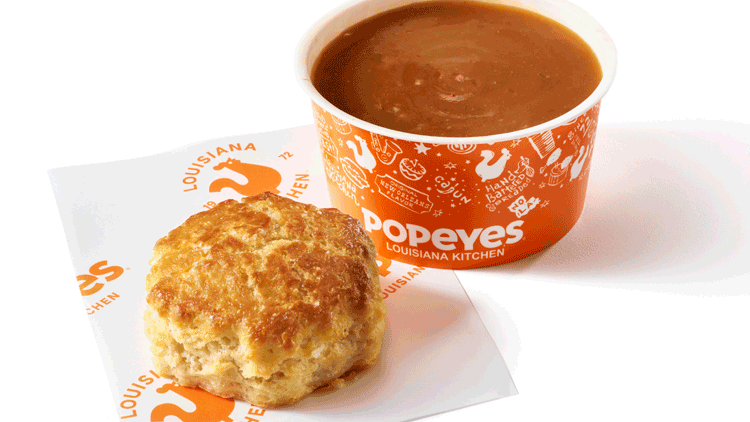
![popeyes_20112021-72_(1)[1]](/var/wrbm_gb_hospitality/storage/images/media/images/popeyes_20112021-72_-1-1/5978389-1-eng-GB/popeyes_20112021-72_-1-1.jpg)
![popeyes_20112021-123_(1)[1]](/var/wrbm_gb_hospitality/storage/images/media/images/popeyes_20112021-123_-1-1/5978407-1-eng-GB/popeyes_20112021-123_-1-1.jpg)
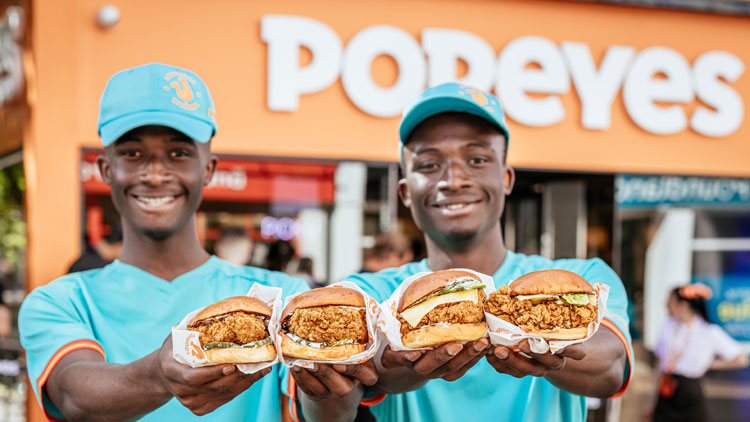
![Popeyes_DT[1]](/var/wrbm_gb_hospitality/storage/images/media/images/popeyes_dt-1/5978443-1-eng-GB/Popeyes_DT-1.jpg)
